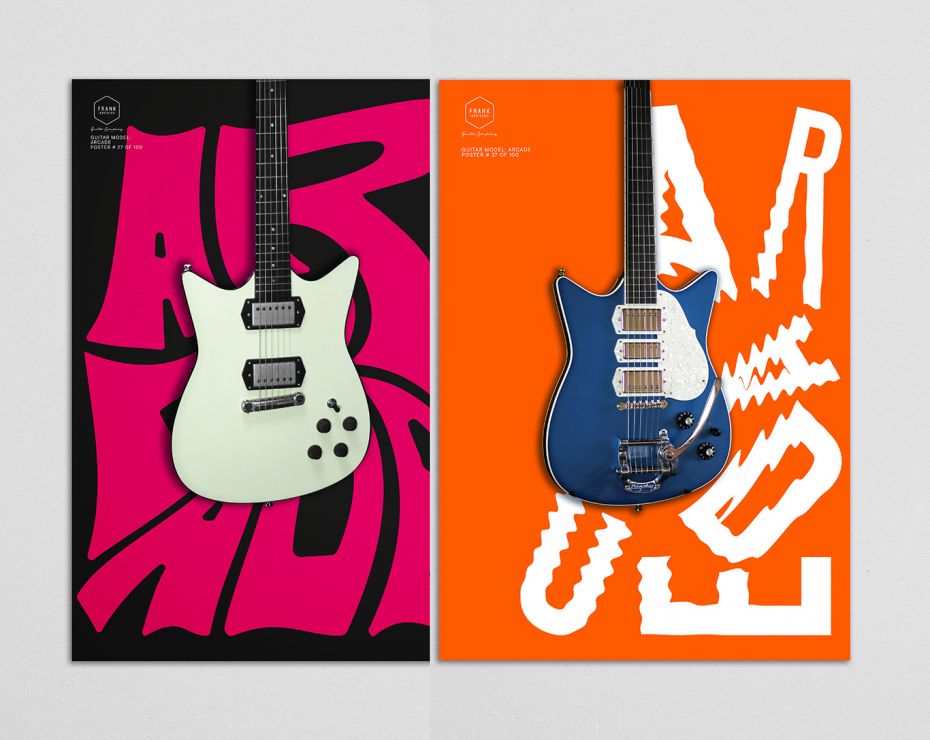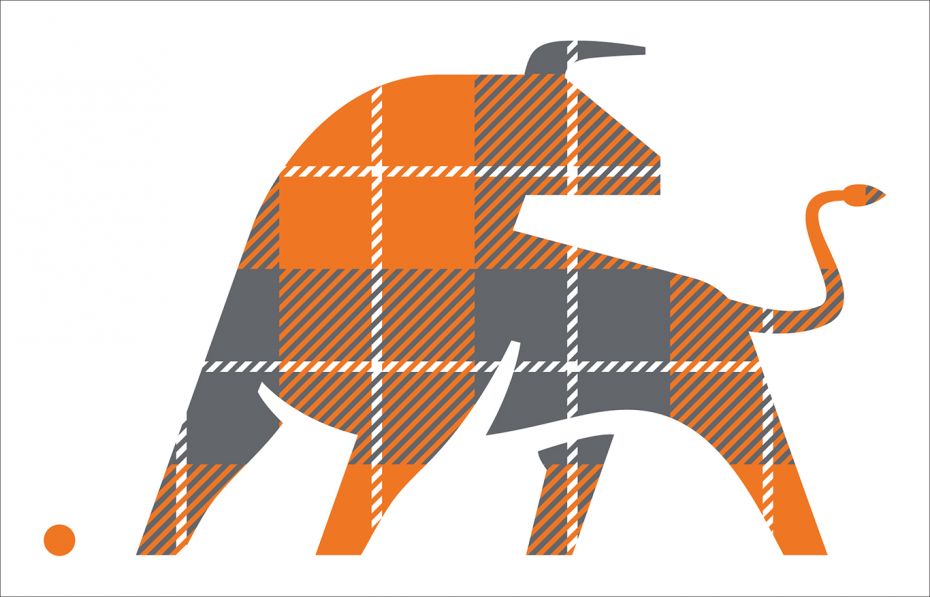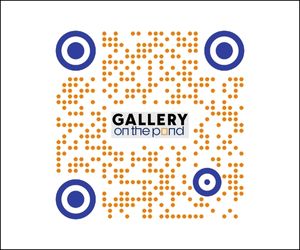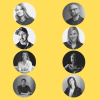Design Revised
The universal principles of design have not changed, but everything else has. How are we dealing with those changes, and where will they take us?
January 24, 2020
“Changes?”, asks James Wilson, founder and principal of Overdrive, a firm which has surfed the leading edge of graphic design practice for the last 30 years. “Hmm. I need to think about that.” I’ve just asked James what he feels are the biggest changes that have affected design practice in the last 5-10 years, and how he has coped with them.

DDB, Posters for Frank Brothers Arcade Series of guitars. The goal was to bring the guitar name to life sonically with visuals.
We’re scarfing down nigiri and maki in a sushi joint just down the street from Overdrive’s new offices on King Street East in Hamilton, Ontario. Anyone familiar with the recent history of this rust belt city knows that what used to be central Canada’s steelmaking giant has long since fallen on hard times, one half of its once-lively commercial district boarded up, the other populated by struggling small businesses.
Though located on a scruffy thoroughfare, Overdrive is certainly not struggling. Its bold move to the ‘Hammer’, as the industrial town is affectionately referred to by its denizens, is itself a signal of the changes we have met to discuss. “Before moving here, we were located in the Junction district in Toronto. When we first moved there, it wasn’t much different than what you see here in downtown Hamilton.” The Junction, so named because it is situated at the intersection of three railway lines, suffered a similar post-industrial fate to that of the Hammer. But in the last 5 or 6 years it has rapidly gentrified, a reversal driven by the ever-rising value of Toronto real estate. When Overdrive’s new landlord abruptly announced that they were doubling the rent on their Junction office space, it was time to look for a new home. Since Oakville is home and many of the staff come from the Kitchener/Waterloo region, Hamilton started to make sense.
“The amount of skills that you have to come out of school with just keeps getting larger.”
“The changes have been coming for so long, I haven’t really noticed anything abrupt. It’s just been a continuous process, and it’s been non-stop. The only difference I can see in the last 5 years is that the rate of change has accelerated.” So how does one cope with that? “I just don’t think about it. I try to keep an open mind and just roll with it”, says Wilson.

Overdrive, Merchandising logo for Angus Glen Golf, used on all private label items in the pro shop.
As energetic and scrappy as he was when I first met him over 20 years ago, James is the archetypal early adopter, whether you are talking about technology or urban geography. Not everyone is as capable of surfing the entrepreneurial edge with as much aplomb as Overdrive, but ya gotta give it up for a firm that describes itself as a bunch of “Design thinkin’, problem solvin’ sons o’ guns”.
The Changes ~ In the musical genre of jazz, the term ‘changes’ refers to the basic underlying chord changes that define all jazz standards. Since jazz is fundamentally an improvisatory art form, a standard like “Spring Can Really Hang You Up the Most” or “A Fine Romance” will always have the same chord changes but can be arranged or interpreted a million different ways. The whole point of jazz is to improvise on top of the ‘changes’ so that the tune never sounds the same twice. Improvisation is therefore standard operating procedure. No improvisation, no jazz.
Running a design practice in the last 5-10 years has not been much different. The universal principles of design haven’t changed, but everything else has, forcing designers to respond to those changes in ways they may have never imagined. Some have adjusted the mix of talent, some have joined forces with large ad agencies, consulting firms and tech companies, while others have simply upskilled from page to screen without missing a beat.
To get a sense of how their practices have had to respond, we spoke with seasoned practitioners across Canada. There are the obvious, overarching forces at work: technology and economics. But with those come the demand for changing skillsets, the mastery of new media, delivering more and more for less and reimagining what it means to be a designer at all in this dynamic environment.

Studio Baillat, Development of the identity and campaign for the conference RDV Design presented in Montreal by Infopresse. The scope included web, video, scenography, publicity, magazine and notebook.
Changing Skills ~ When this writer began his career as a graphic designer in the late 70’s, print was king and you entered the field with the expectation that this would never change. Mastering the art of designing for print seemed like a mission that could carry you for your entire career, as indeed it had for the previous generation. The focus was on leveraging the continuous improvements and refinements of printing and typesetting technology so that your designs would be reproduced with optimal fidelity. Looking back on those days, that now seems as quaint as making horseshoes when automobiles started rolling off the assembly lines at Detroit’s Ford plant in 1910. Who knew that in a scant few years horses would almost entirely disappear from the streets, along with the centuries-old craft of blacksmithing?
Something very similar happened in the graphic arts industry in the mid-to-late 80’s. With the advent of desktop publishing, centuries-old crafts evaporated overnight. Typesetting was the first to go. Within a few years the 500-year-old industry completely collapsed. No one under the age of 40 will remember what an impact that had on designers, not to mention an entire generation of typesetters. We were suddenly empowered by these little grey Macs to set type ourselves, something most of us were woefully incapable of doing with anywhere near the same level of craft as a seasoned typesetter.

Paprika, Identity and applications for Reflector Entertainment, a company focused on cross-platform storytelling. It creates entire worlds for fans to explore, offering multiple points of entry into its storyworlds. The rebrand was about giving the company an image that would become an extension of its innovative business model.
Thankfully the quality of desktop type greatly improved with each new leap in memory capacity, so we were all saved by Moore’s Law. But even after all these years I challenge anyone to show me a page on a website – or even on paper – as perfectly set as a page from Gutenberg’s bible of 1455. A great deal of type-craft has been lost.
“The biggest change I’ve seen in recent years is that designers have to become content creators, because you’re not getting your content from your client. You’re getting a whiff of a problem that they need to solve and you have to create your own content for that. You have to get comfortable with it and dive in.”
Fast forward to now and the designer’s tool belt looks very little like it did then. Says James Wilson, “The amount of skills that you have to come out of school with just keeps getting larger. For instance, we keep pushing for at least working knowledge of code. That doesn’t mean you have to be an expert but having some basic knowledge of HTML, CSS and Javascript is a big help. Beyond that, for me, there is an expectation that you can use a camera, that you can draw, that you can think critically and command all the basic software, even if it’s just Adobe Illustrator, Photoshop and InDesign.”
Wilson’s expectations are augmented by the comments of Calgary-based Rita Sasges, who has had her own shop, in one form or another, for the last 26 years. Also a long-time professor at Alberta University of the Arts (formerly Alberta College of Art and Design), she says “the biggest change I’ve seen in recent years is that designers have to become content creators, because you’re not getting your content from your client. You’re getting a whiff of a problem that they need to solve and you have to create your own content for that. You have to get comfortable with it and dive in.”
In a world ruled by such a voracious demand for content, firm owners sometimes need to get out of their comfort zone when it comes to staffing. Peter Scott and Glenda Rissman of Toronto-based q30 began their practice in 1992. Since then they have seen all the same kinds of changes and have hired carefully in response. Says Scott, “I would say that if a firm of our size, which is 10 to 15 people, wants to own and deliver complex digital assignments, you’re hiring people who have a knowledge and a capacity that’s beyond your core skillset, which is exciting and uncomfortable all at the same time. It’s a bit of a leap of faith.”
Montreal-based Jean-Sebastien Baillat, founder/owner of Studio Baillat takes a flexible approach to staffing. While he has maintained a core staff of about 10-12 people, he will often rely on outside collaborators to double or triple the team size in response to project requirements. He prefers the opportunity to bring in special skills on a project basis rather than hire them full time. Having come to design through his involvement in the Montreal techno music scene back in the 90’s and having studied and trained in cinema, he has always been a multidisciplinary practitioner himself, which explains his firm’s involvement in the design of immersive experiences. He is used to working with large creative and production teams that form for the duration of the project and then disband.
Says Baillat, “At some point you need to make a staffer work on something they’re not so great at and they don’t like so much, just to keep them busy. I’d rather rely on collaborators who are best-in-class and jump in and out as required. It keeps things fresh for you and your full-time employees ”.

Cossette, An upgraded visual identity for the Children’s Hospital Foundation of Montreal uses the simple bandaid to build an infinitely varied vocabulary of colors and shapes, all inspired by the words ‘heal’, ‘love’ and ‘bond’.
From firm to agency ~ The line between graphic design and advertising used to be much more clearly delineated than it is now. Barry Quinn, former Chief Design Officer at DDB North America puts it this way: “Historically, the relationship between design and advertising has not been easy. In the old days, people (in marketing and advertising) used to talk about above the line and below the line. The new reality is that there is no line.”
Quinn’s role as North American head of design for a global ad agency, and a venerable one at that, is not a unique title, but as little as 5 years ago it would have been. “Now”, he says, “I think the worlds of advertising and design are actually very complementary. The problems that we’re each uniquely qualified to solve are quite different, but they are often needed by the same client. I break it down into two very simple words: ‘telling’ and ‘being’. Advertising has historically done the telling: let me tell you why we’re cool, let me tell you why we’re human, let me tell you why you should buy. But design is more about if I want my company to be easy, well our design has to be easy to use. It has to be the things that it says it is largely because it’s an experience”.
The challenge for agencies is to do the ‘telling’ across many more touchpoints, with lots more content. The core skills of any brand identity designer are a perfect fit for maintaining brand consistency in such a variegated, dynamic communications ecosystem. Quinn agrees: “It’s just crazy to not have a visual strategy for how to link the many disparate touchpoints together so that they all ladder up to a consistently positive association with the brand”. That’s what designers are for.
Across town, Michel Viau’s Ove Design has been a part of global communications behemoth Publicis for almost 20 years, so none of this is new for him. He talks about how being part of this larger organization has helped his business. “I have access now to all these resources. So when people say to me, well, how many people work at Ove? and I’m like, well, I don’t know, what number would you like? If you want me small, I can say there’s 25 people. If you want me to be big, I’ve got the global Publicis network. So now we resource around the client. That’s changed us in the sense that the first thing I do when I get an account is to sit down with a client and ask what do you want to do? So let’s build the kickass team to do that. I’ve got the world, really. Let‘s just look at who will be available to us. I never used to do this as a standalone design firm”.

Frank Design, HomeSpace Society is a local not-for-profit developing and managing housing for disadvantaged Calgarians. Frank created a fundraising tool called the “What’s in Your Pantry” cookbook, with recipes based on the ingredients found in a common foodbank hamper. The recipes were from HomeSpace clients, supporters, and staff, with feature recipes contributed by Alberta chefs.
Then there’s Cossette, which started out in 1972 as a design firm. Now a full-service agency with offices across Canada, it is responsible for some of the best design work in the last 5 years. Says Barbara Jacques, VP Branding & Design, “We don’t often speak about design here. For me, it’s too narrow. It’s so much more than that - we are more focused on the brand and the attributes of the brand when we communicate. We are concerned about the brand experience”. If last year’s award-winning campaign for McDonalds was any indication, she is right. It won at Cannes for its innovative use of the logo as a directional device in outdoor advertising.
Motion and Multiple Executions ~ As with photographers and illustrators, client demands for volume and variety of content have pushed designers out of their static world and into the world of motion and multiple executions.
JS Baillat concurs. “I remember when we did the Red Bull Music Academy a few years back. A client like that wants to use the latest new tactics and techniques to build their brand. We made some animated gifs as part of the overall deliverable. Everybody was like, “those things are amazing”. And then suddenly everybody wanted animated gifs. Suddenly everybody wanted things to move - not only videos, but static images as well”.
Joanne Lefebvre, President of Paprika Communications in Montreal links it back to the brand’s desire to be brought to life in ever more compelling ways. “I would say that motion is becoming one of the most effective tools for that. To be animated just brings it closer to how we as humans behave as we move through time and space. Motion is life.”
The constant demand for changing content has created the need for multiple executions. The days of only being able to print one or two images in a single run are long gone. Advances in today’s digital printing have made it possible to execute as many variations on your theme as your budget will allow, opening up new possibilities for expression. Says JS Baillat: “I think now that we can do that, clients are excited by the way you can use digital printing to extend a brand’s storytelling capability. A month ago we launched a book by Pete Savage, a Montreal writer. We did 100 different versions of the dust jacket”.
From Design to Consulting ~ The business model of a typical design firm is the consulting model, with the big difference that, unlike consultants, designers actually produce an end product. Designers possess the craft and skill to create artefacts and experiences of great beauty and messaging power. Consultants just consult.
Not that there is no value in just consulting. What is beginning to happen for some practitioners is that they are being engaged as consultants with no expectation that they will produce the end result. Says Glenda Rissman of q30: “We are finding that in some of the RFPs we’re getting, the scope is really not well defined and we get asked to help define it. There’s so much strategic thinking in that process that I think clients are starting to see it as a hugely beneficial service in and of itself that should be properly compensated. Saves them money in the long run to get the RFP properly set up”.
Rita Sasges has glimpsed the value of consulting vs designing as well. Says Sasges "At some point I became very good at taking clients through the process, not the creative process, but the thinking process, which I think are two very different things. And I think a big mistake that designers make is to try and sell their creative process when they need to be selling their thinking process”.
The New World of Design ~ Barry Quinn is very optimistic about the future of design. “I think the great thing about being a designer today is there are so many options. You can work in a boutique setting. There are still great opportunities for that. If you want to work in the digital realm you can do that. If you want to work on larger projects with complete systems and a full range of brand touchpoints, you can work in an agency. If you want to work in-house at a tech company or a consulting firm, there are more and more opportunities for that too”. And as Glenda Rissman and Rita Sasges point out above, you can, if you so choose, apply the principles in the context of pure consulting.
While the possibilities have expanded, so too have the challenges. Designers need to be more media agnostic if they are to successfully navigate the waves of disruption that are transforming every sphere of human activity. They need to learn how to deal with newer and more complex technologies like AR and VR. As Michel reminds us, “5G is just around the corner. Coupled with the rise of AI, this will change our lives as much if not more than the internet has. As designers, we should be curious about the opportunities that lie ahead for us. I’m still doing what I’m doing because I’m curious about that. What will it mean to be a designer in 2025 or 2030? That’s what keeps me going.”
By Will Novosedlik







